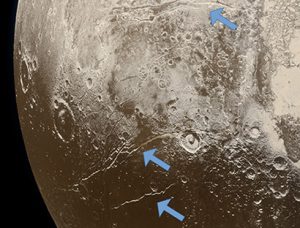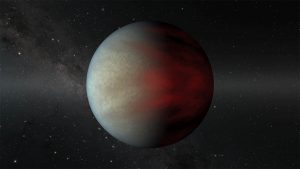Media
Transcript
Today’s news seems to be designed by Blathers of Animal Crossing: we get one of everything, but only one and no more. For instance, let’s consider Pluto: we got one and only one flyby of one and only one large Kuiper Belt object (KBO). This means, when we try to understand new ideas about this distant world, we can only look at the data we already have in new ways and hope to find what we need.
This kind of “let’s look through the data in a fresh way” forging can turn up awesome results. For instance, researchers at University of California Santa Cruz (UCSC) wanted to understand how Pluto formed and managed to maintain a subsurface liquid ocean, despite being at the edge of the solar system, so they did some theory work and then went looking through the New Horizons data to find out what the data said was possible.
There were two schools of thought prior to today’s story. The first group said Pluto started out cold and by some unknown process, its internal ice melted. The other group said Pluto had a “hot start,” with oceans that later froze out. Conveniently, these two theories produce a Pluto that looks slightly different. The hot start theory requires evidence of expansion features on the surface, that would form as the ice expanded while freezing. An event that melts the oceans later would likely be associated with compression features, however.

Seeking to put an end to the “where did the oceans come from” debate, a team of researchers at UC Santa Cruz poured through the data and found clear evidence of a hot past. As first author and UCSC graduate student Carver Beirson explained: We see lots of evidence of expansion, but we don’t see any evidence of compression, so the observations are more consistent with Pluto starting with a liquid ocean.
Of course, these observations lead to a second question: where did Pluto get the energy for a “hot start”? The two main sources of planetary heat are radioactive decay and gravitational energy from the planetary formation. It’s unlikely that radioactive materials could generate as much energy as is needed, but a really fast formation could do the trick. Coauthor Frances Nimmo explained that “if [the gravitational energy] builds up fast enough the heat gets trapped inside.”
To contain enough heat to keep a liquid ocean, Pluto would have to have formed in under 30,000 years. Any slower, and heat would have time to radiate away to surrounding space instead of getting trapped inside Pluto. These findings could mean that large KBOs, such as Eris and Makemake, could also have similar icy oceans if they formed in a similar fashion.
Clearly, one flyby of one large KBO is not enough, and we are really hoping to someday get more data.
One of the running jokes in astronomy has been that one object is a paper on a new phenomenon, two to five is the start of a new field of investigation, and at six examples you get to start doing statistics. This has started to change with large scale surveys of the sky. There is still a problem with there being so many things out there that have only been seen a handful of times, that it is easy to rediscover things by accident. The time and energy that goes into the whole “we have discovered” process prior to realizing you haven’t actually discovered something, well, it’s a lot. To try and make it easier to know what’s already out there, folks have been making and sharing catalogues for hundreds of years. Charles Messier’s catalog of bright extended objects was originally intended to help people know when they had found an actual comet and when they had just rediscovered a globular cluster for the Nth time.

Today, this “let’s make a catalogue” tradition is carried forward by the Breakthrough Listen project, which is taking more of a guidebook approach to listing out what can be found among the stars. They list out more than seven hundred distinct radio targets with the goal of describing one of every kind of naturally occurring radio signal. Like a nature guide, it doesn’t just list what prototypes for each class of objects should look like, it also lists out the extremes that can be seen. There are also objects that are anomalies, and here I’m going to quote what that means directly from the press release: Anomalies are enigmatic targets whose behavior is currently not satisfactorily explained. For instance, the famous “Tabby’s Star” with its bizarre dimming behavior; ‘Oumuamua — the interstellar object that passed near Earth in 2017; unexplained optical pulses that last mere nanoseconds; and stars with excess infrared radiation that could conceivably be explained as waste heat from alien megastructures.
Yes, folks, I said alien megastructures. Now they aren’t trying to say there are aliens; they are trying to say there could be aliens and to make it as easy as possible to identify them against the background noise of our universe. Just as the Messier catalogue made it easier to discern the real comets against the background of clusters, nebulae, and galaxies that litter the sky, it is hoped that the Breakthrough Listen project’s catalogue will make it easier identify possible signs of extraterrestrial life against the background of pulsars, quasars, and young stars that all emit their own radio signals naturally. The catalogue also discusses what different technosignatures of advanced civilizations could look like. This catalogue also contains control samples that shouldn’t produce signals and can be used to calibrate instruments, as well as a discussion on how to classify both the included objects and future new kinds of radio sources. While the authors’ goal is to make finding life easier, this catalog will benefit the entire field. As put by lead author Brian Lacki: The catalog is not just limited to SETI, though. My hope is that any program with a new capability may use the Exotica catalog as a shakedown cruise around the universe.
Ultimately, to understand our universe, we want to find more than one of everything. Heck, we really want to find more than six or even six hundred. We want complete populations of objects so we can understand every facet of an object in every possible combination of circumstances, but sometimes, just finding one is hard enough.

We’ve known since the 1990s that massive, Jupiter-like worlds can exist snuggled up to their host stars. What we haven’t known is how they get there. It could be they formed there or migrated there at some point in their solar system’s history. It could even be all of the above. To understand these systems, we need examples of young stars with young planets so we can see what is possible.
And finally, we have one example. HIP 67522b is a hot Jupiter found in data from NASA’s Transiting Exoplanet Survey Satellite (TESS) that is orbiting its star every seven days. That star is only 17-million-years old, and that makes this a young planet. While we still can’t know if the world formed there or migrated there early in the star system’s history, this singular example does tell us that not all hot Jupiters migrate there a billion or more years into a solar system’s evolution. It is a start. One object can be the start of an awful lot of science, but here is hoping they find many more examples quickly.
Learn More
Evidence supports ‘hot start’ scenario and early ocean formation on Pluto
- UC Santa Cruz news article
- “Evidence for a hot start and early ocean formation on Pluto,” Carver J. Bierson, Francis Nimmo & S. Alan Stern, 2020 June 22, Nature Geoscience
“Exotica” Catalog — One of Almost Everything in the Universe
- Breakthrough Initiatives press release
- “One of Everything: The Breakthrough Listen Exotica Catalog,” Brian C. Lacki et al., 2020 [preprint pdf]
Young Giant Planet Offers Clues to Formation of Exotic Worlds
- NASA Jet Propulsion Laboratory press release
- “TESS Hunt for Young and Maturing Exoplanets (THYME). II. A 17 Myr Old Transiting Hot Jupiter in the Sco-Cen Association,” Aaron C. Rizzuto, 2020 June 22, Astronomical Journal (Preprint on arxiv.org)
Credits
Written by Pamela Gay and Beth Johnson
Hosted by Pamela Gay
Audio and Video Editing by Ally Pelphrey
Content Editing by Beth Johnson
Intro and Outro music by Kevin MacLeod, https://incompetech.com/music/


 We record most shows live, on Twitch. Follow us today to get alerts when we go live.
We record most shows live, on Twitch. Follow us today to get alerts when we go live.